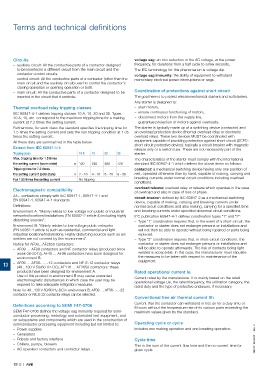Page 830 - Motor_protection_and_control_Manual_motor_starters_ contactors
P. 830
Terms and technical definitions
Circuits voltage sag: an rms reduction in the AC voltage, at the power
– auxiliary circuit: All the conductive parts of a contactor designed frequency, for durations from a half cycle to a few seconds.
to be inserted in a different circuit from the main circuit and the The IEC terminology for this phenomenon is voltage dip.
contactor control circuits. voltage sag immunity: the ability of equipment to withstand
– control circuit: All the conductive parts of a contactor (other than the momentary electrical power interruptions or sags.
main circuit and the auxiliary circuit) used to control the contactor's
closing operation or opening operation or both.
– main circuit: All the conductive parts of a contactor designed to be Coordination of protections against short circuit
inserted in the circuit that it controls. The goal here is to protect electromechanical starters and softstarters.
Any starter is designed to:
Thermal overload relay tripping classes – start motors,
IEC 60947-4-1 defines tripping classes 10 A, 10, 20 and 30. Types – ensure continuous functioning of motors,
10 A, 10, etc. correspond to the maximum tripping time for a making – disconnect motors from the supply line,
current at 7.2 times the setting current. – guarantee protection of motors against overloads.
Furthermore, for each class the standard specifies the tripping time for The starter is typically made up of a switching device (contactor) and
1.5 times the setting current and sets the non tripping condition at 1.05 an overload protection device (thermal overload relay or electronic
times the setting current. overload relay). These two devices MUST be coordinated with
All these data are summarized in the table below. equipment capable of providing protection against short circuit (SCPD:
short circuit protective device): typically a circuit breaker with magnetic
Extract from IEC 60947-4-1: release only or a switch fuse. These are not necessarily part of the
Tripping class 10 A 10 20 30 starter.
Max. tripping time for 1.5 times The characteristics of the starter must comply with the international
the setting current (warm state) s 120 240 480 720 standard IEC 60947-4-1 which defines the above items as follows:
Tripping time for 7.2 times contactor: a mechanical switching device having only one position of
the setting current (cold state) s 2 - 10 4 - 10 6 - 20 9 - 30 rest, operated otherwise than by hand, capable of making, carrying and
For 1.05 times the setting current No tripping breaking currents under normal circuit conditions including overload
conditions.
Electromagnetic compatibility overload release: overload relay or release which operates in the case
of overload and also in case of loss of phase.
AF... contactors comply with IEC 60947-1, 60947-4-1 and circuit-breaker: defined by IEC 60947-2 as a mechanical switching
EN 60947-1, 60947-4-1 standards.
device, capable of making, carrying and breaking currents under
Definitions: normal circuit conditions and also making, carrying for a specified time
Environment A: "Mainly relates to low-voltage non public or industrial and breaking currents under specified abnormal circuit conditions.
networks/locations/installations (EN 50082-2 article 4) including highly IEC publication 60947-4-1 defines coordination types "1" and "2":
disturbing sources". – Type "1" coordination requires that, in the event of a short-circuit, the
Environment B: "Mainly relates to low-voltage public networks contactor or starter does not endanger persons or installations and
(EN 50082-1 article 5) such as residential, commercial and light will not then be able to operate without being repaired or parts being
industrial locations/installations. Highly disturbing sources such as arc replaced.
welders are not covered by this environment". – Type "2" coordination requires that, in short-circuit conditions, the
Notice for AF09…AF2650 contactors: contactor or starter does not endanger persons or installations and
– AF09 … AF38 contactors and NF contactor relays (produced since will be able to operate afterwards. The risk of contacts being light
week 08-2013), AF40 ... AF96 contactors have been designed for welded is acceptable. In this case, the manufacturer must stipulate
environment B. the measures to be taken with respect to maintenance of the
equipment.
13 – AF09 … AF38-..-..-12 contactors and NF..E-12 contactor relays
(48...130 V 50/60 Hz-DC), AF116 ... AF2650 contactors: these
products have been designed for environment A. Rated operational current Ie.
Use of this product in environment B may cause unwanted Current rated by the manufacturer. It is mainly based on the rated
electromagnetic disturbances in which case the user may be operational voltage Ue, the rated frequency, the utilization category, the
required to take adequate mitigation measures.
rated duty and the type of protective enclosure, if necessary.
Note: for 48...130 V 50/60 Hz-DC in environment B, AF09 … AF38-..-..-22
contactor or NF..E-22 contactor relays can be selected.
Conventional free air thermal current Ith
Definitions according to SEMI F47-0706 Current that the contactor can withstand in free air for a duty time of
8 hours without the temperature rise of its various parts exceeding the
SEMI F47-0706 defines the voltage sag immunity required for semi- maximum values given by the standard.
conductor processing, metrology and automated test equipment, and
on subsystems and components which are used in the construction of
semiconductor processing equipment including but not limited to: Operating cycle or cycle
– Power supplies Includes one making operation and one breaking operation.
– Generators
– Robots and factory interface Cycle time 1SBC101625S0201 - Rev. C
– Chillers, pumps, blowers This is the sum of the current flow time and the no-current time for
– AC operated contactors and contactor relays... given cycle.
13/12 | ABB

